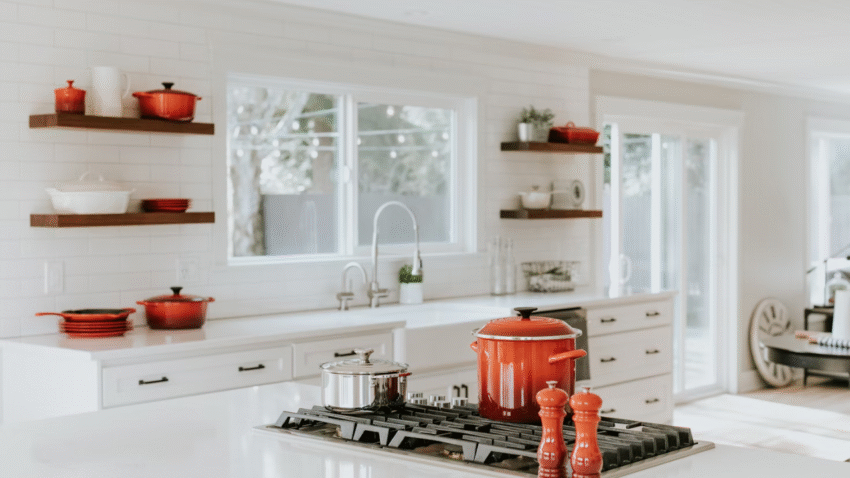Introduction
If there’s one tool that every home cook should master, it’s the chef’s knife. In this complete guide, you’ll learn how to properly use a chef’s knife for safe, efficient, and precise cutting. Tired of slow prep work or struggling with awkward chopping? Once you understand proper grip, motion, and technique, the chef’s knife becomes an extension of your hand—transforming your kitchen experience.
Why Using a Chef’s Knife Properly Matters in the Kitchen
A chef’s knife is the most versatile tool in the kitchen. It handles everything from mincing garlic and slicing onions to chopping herbs and breaking down vegetables. But without proper technique, it can slow you down—or worse, cause injury.
Here’s why mastering the chef’s knife matters:
- Improves cutting speed and efficiency
- Ensures consistent results in size and texture
- Reduces risk of injury through safe handling
- Preserves ingredient freshness by avoiding bruising or crushing
- Builds kitchen confidence and enjoyment
Whether you’re prepping for a weeknight meal or experimenting with gourmet recipes, solid knife skills make everything easier.
Step-by-Step Guide to Using a Chef’s Knife Correctly
Let’s break down the essential techniques to help you use your knife like a pro.
1. Choose the Right Knife
Start with an 8-inch chef’s knife made from high-quality stainless steel or carbon steel. It should feel balanced in your hand—not too heavy or too light.
Pro Tip: Visit a kitchen supply store and test different knives before choosing one. A comfortable grip and good weight are essential.
2. Hold the Knife Properly
Grip the knife where the blade meets the handle (called the bolster).
- Wrap your thumb and index finger around the blade
- Curl your remaining fingers around the handle
This is called the pinch grip—it gives you more control and balance compared to holding the handle only.
Bonus: Use your non-dominant hand to hold ingredients in a claw grip—fingertips curled under and knuckles facing forward. This keeps your fingers safe and guides the knife.
3. Use the Right Cutting Motion
Avoid pressing straight down or chopping like a guillotine. Instead, use a rocking motion:
- Anchor the tip of the knife on the board
- Push the blade forward and down, then lift and repeat
The rocking technique is smoother, safer, and more efficient for most kitchen tasks.
4. Stabilize Your Ingredients
Always create a flat surface before cutting. For example:
- Slice a carrot or onion in half lengthwise before chopping
- Lay vegetables flat to prevent rolling
A stable base makes cutting safer and more precise.
5. Master the Basic Knife Techniques
Here are some foundational moves every cook should know:
Slicing
Used for cucumbers, zucchini, onions, etc.
- Cut with a smooth, rocking motion
- Keep slices uniform for even cooking
Dicing
Great for onions, tomatoes, carrots.
- Cut into planks, then strips, then cubes
- Control the size based on the recipe
Mincing
Best for garlic, herbs, and aromatics.
- Rock the blade back and forth over small items
- Use your non-knife hand to keep the tip steady if needed
Chopping
Ideal for rougher cuts (e.g., potatoes or cabbage).
- Use downward force while keeping control
- Can be faster and less precise for rustic dishes
Kitchen Tip: Always keep the tip of the blade in contact with the board when chopping for more control.
Common Mistakes to Avoid
Many home cooks pick up bad habits that can lead to frustration or injury. Here’s what to avoid:
Mistake 1: Using a Dull Knife
Solution: Dull blades require more force and are more likely to slip. Sharpen your knife regularly and hone it with a honing rod between uses.
Mistake 2: Holding the Knife Wrong
Solution: Ditch the “hammer grip” and use a pinch grip on the blade. It offers more control and stability.
Mistake 3: Chopping With Elbows Out
Solution: Keep your elbows tucked in and let your wrist and shoulder guide the knife naturally.
Mistake 4: Cutting on a Slippery Surface
Solution: Always place a damp towel under your cutting board to keep it from sliding.
Mistake 5: Using the Knife for the Wrong Task
Solution: Don’t use your chef’s knife to open cans, pry things apart, or cut bones. Use appropriate tools like a can opener or cleaver instead.
Extra Tips & Kitchen Hacks
Take your knife skills even further with these kitchen-tested tricks:
1. Use a Bench Scraper, Not the Knife Edge
When transferring chopped food from the board, use a bench scraper. Scraping with the knife edge dulls the blade over time.
2. Keep a Separate Knife for Raw Meats
To prevent cross-contamination, consider using one knife for produce and another for raw meat—especially during batch cooking.
3. Build Muscle Memory
Practice chopping carrots, celery, or onions to build speed and consistency. With repetition, your knife work will become second nature.
Related task to check next: [How to Chop Vegetables Like a Chef]
Conclusion
Learning how to properly use a chef’s knife is one of the best investments you can make in your cooking journey. With the right grip, motion, and habits, you’ll prep ingredients faster, safer, and more confidently.
Let’s recap:
- Use a pinch grip for control
- Keep the blade sharp and clean
- Cut with a smooth rocking motion
- Practice basic techniques like slicing, mincing, and dicing
- Avoid common mistakes and build smart habits
✅ Bookmark this guide and start building professional-level knife skills one meal at a time!
